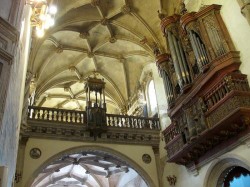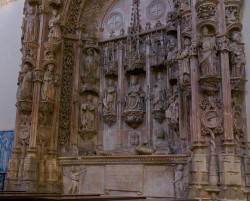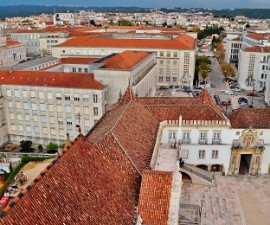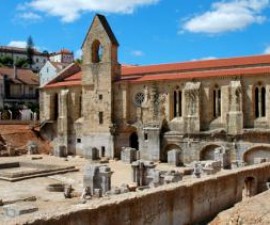Santa Cruz Church, or the Monastery of Santa Cruz as it also known, is one of Portugal’s official National Monuments and is found in the Praça de Maio, right in the heart of the city centre.
The Santa Cruz Church is historically important, both for its Romanesque and Baroque architecture and for the fact that the first two kings of Portugal, Afonso Henriques and his successor, Sancho I, are buried there.
At the time of the formation of the Portuguese Royal Family, it was Coimbra that was declared the capital city and the Royal Family’s official seat of residence. Because of the royal burials, the site is also a National Pantheon.
The original monastic building was founded in 1131 and, in the early days of the monarchy, it was the most important building of its type. It was granted many privileges and accumulated significant wealth, as well as being an important seat of learning in medieval times. King Afonso Henriques used the scriptorium to consolidate his royal powers.
It was built in Romanesque style, with one nave and a high tower above the façade, but was replaced in later years with a new monastery, whose church and cloister were built in the popular Manueline style of the period.
This building and renovation project took place during the early part of the 16th century and was led by the architect Diogo Boitac, at the behest of King Manuel. Like the Romanesque church before it, the new building also took the form of a single nave, with the addition of several laterals.
The façade was fully renovated in 1507, a project which took some six years to complete, and the main portal was constructed by Diogo de Castilho in 1522, enhanced by sculptures by Nicolau Chanterene. There are three interesting sculptures in the central section by Joao de Ruao, who also made important artistic contributions to the Old Cathedral. The three artworks depict the Prophet, King David and Our Lady.
When the main renovation works were completed, in 1530, the tombs of King Afonso and King Sancho I were transferred to the main chapel. Here they remain today, interred beneath a sculptural piece by Nicolau Chanterene. Chanterene also carved the decorative pulpit.
Later architectural modifications and additions came in the form of a Baroque triumphal arch and an ornate Baroque pipe organ. The latter was the work of Manuel Brito Gomes Herrera, who completed it in 1724.
Santa Cruz Church is something of a hidden gem in the city of Coimbra, Portugal. Nestled in a busy commercial street, it would be easy to pass by without paying it the attention it deserves, but it certainly merits a stop in the itinerary of any sightseeing visitor to Coimbra.
Beautiful ceramic tiles, statues, stonework and glass are found in abundance, setting off the exquisite architecture to perfection. It is possible to visit free of charge but the small additional fee for a tour of the sacristy and other areas is well worth paying.





